Most crossovers have – or offer – all-wheel-drive.
Most SUVs have – or offer four-wheel-drive. Both systems drive all four wheels, but AWD is usually less capable off-road than 4WD. On the other hand, AWD has the upside of fewer parts, less weight and so (usually) better gas mileage and handling, on road.
The Jeep Renegade is a crossover that offers an AWD system with similar-to-SUV 4WD capability. Without the additional parts, weight and gas costs that usually come along for the ride with 4WD.
Or the cost.
What It Is
The Renegade is a compact-sized crossover that’s generally similar to others about the same size, such as the VW Taos and the Mazda CX-30.
Other small crossovers have (or offer) a light-duty all-wheel-drive system that differs from the 4WD systems most SUV have (or offer) in that they do not have a gear-reduction function – i.e., Low Range.
That limits what they can handle off-road (and when there’s deep snow, on the road).
The Renegade offers that function – without the addition of a two-speed transfer case and the weight and expense that comes with it. Instead, it uses the transmission -in Trailhawk versions – to provide a similar leverage advantage for bullying through deep snow (and mud, off-road).
Base price is $27,805 for the Latitude trim, which comes standard with a lighter-duty AWD system that’s more like the ones that come standard with or are available with other small crossovers.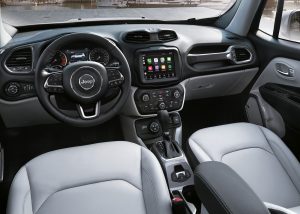
A top-of-the-line Limited lists for $32,845.
The Trailhawk – which comes with more ground clearance (8.7 inches vs. 8 for other trims) as well as underbody skid plates, 17-inch wheels with all-terrain tires, tow hooks and other upgrades to make it more capable off-road – lists for $31,945.
What’s New for 2024
Other than a slight shuffling of trims – including the dropping of the formerly available Sport trim – the ’24 Renegade carries over unchanged. It has not changed much since 2015, in fact – so 2024 is likely to be the last year for the current-design Renegade before it gets rebooted for 2025.
That may and likely will include at least partial “electrification,” i.e., a hybrid drivetrain. So if you don’t want that (or a probably huge LCD touchscreen) you’ve got one more model year to avoid both.
What’s Good
More available capability in a crossover that isn’t an SUV.
Looks more like an SUV than the typical crossover.
Lower cost than most SUVs.
What’s Not So Good
Standard engine is small for the weight – and there’s no optional engine.
Gas mileage isn’t much better than that returned by many SUVs – with much larger (and stronger) engines.
Premium fuel required.
Regardless of trim, every Renegade is powered by a 1.3 liter four cylinder engine that makes 177 horsepower and 210 ft.-lbs. of torque. The latter figure is stout given how small this engine is – for a four cylinder engine. It is hardly larger than the 1.2 liter three cylinder engine used by GM in some of its smaller vehicles, including the Chevy Trax. But it’s significantly stronger. The Trax’s little three only manages 137 horsepower and 162 ft.-lbs. of torque, which is probably why the ’24 Trax – which you can read more about here – is only available with front-wheel-drive.
A nine speed automatic is standard – as is all-wheel-drive. Most other small crossovers offer it – but come standard with front-wheel-drive. Many also come only with a CVT automatic. 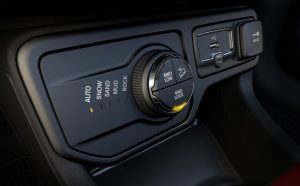
The Jeep offers something else, too
It’s an upgraded Selec-Trac AWD system with a gear-reduction function that multiplies the torque available at low speeds. It is similar in terms of what it does to the two-speed transfer case most 4WD SUVs have – but without the transfer case.
Or the weight – which would typically amount to another 75-100 pounds of deadweight added to the curb weight. The former in italics because most of the time, a 4WD’s transfer case (and low range) are not in use because one generally only needs low range when there’s deep snow on the road or when driving off-road. The rest of the time, it’s like carrying a few sacks of cement around in the trunk – with the effect you’d expect on gas mileage.
And that’s why the Jeep’s mileage – 23 city, 29 highway – is better than what you’d get with a 4WD SUV.
However, it’s not much better.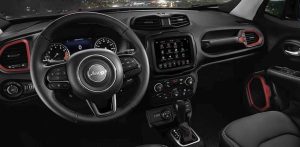
As a point of comparison, a Jeep Wrangler – with 4WD (and a two-speed transfer case) and a much larger V6 engine – still manages 17 city, 25 highway.
Still, it’s a larger vehicle – which you may not want. And it’s an SUV, which also may not want.
On the other hand, you may not want to pay for premium unleaded fuel – which is what the Renegade’s tiny turbocharged engine requires in order to deliver its mileage and performance numbers; you can burn regular – and save some money – but it’ll cost you some mileage (and some performance).
Why not just get – and drive – an SUV?
That’s fine, if you want an SUV. But this Jeep provides a kind of mid-point in between an SUV and a crossover. Which kind of makes it a . . . crossover.
It’s easier to get into than a typical SUV – because it’s not as lifted as many SUVs are – and it’s easier to drive (or rather, to maneuver) than any current four-door SUV, because it is much smaller than they all are.
How small?
It’s just 166.6 inches from front to back.
As a point of reference (again) check out the Jeep Wrangler, which is one of the smallest 4WD SUVs currently available. The four-door version is 188.4 inches long – or almost two feet longer. And that’s about as small as it gets, if you want a four-door SUV. (The Wrangler is available in a shorter, two-door version – but then you only have two doors.)
The Renegade’s shortness makes its turning radius tighter than the typical four-door 4WD SUVs; it’s almost three feet tighter than the Wrangler four door’s (36.3 feet vs. 38.8 feet) and it can fit into tight curbside parking spots the four-door Wrangler must pass by due to its length.
The Trailhawk version has some advantages off-road, too.
These go beyond the additional leverage of the almost-4WD-system this version of the Renegade comes with, that provides a similar gear-reduction function to that of a true 4WD system’s two-speed transfer case and 4WD Low.
Being short is helpful when there’s not much room to back up.
This Jeep’s main deficit is its engine – which is too small (and not strong enough) to lug around 3,200-plus pounds of vehicle (3,532 for the Traikhawk) The stopwatch says it takes about 9-10 seconds for a Renegade to achieve 60 MPH from a dead stop – but it feels longer – and it sounds harder.
On the other hand, the little engine’s torque output is enough to make you feel there might be more engine (and horsepower) than you actually have when you pull away from a dead stop without actually flooring (and holding) it.
The Trailhawk rides (and handles) more like the SUV it isn’t than other versions of this crossover – because it is more stiffly sprung (and higher-riding) than the other versions.
But it also drives “bigger” than it is – due to its relatively long (for its length) 101.2 inch wheelbase. As a point of reference, the two-door Wrangler – which is about the same length (166.8 inches) as this four-door Renegade – has a wheelbase of just 96.8 inches. Ands that’s why it feels tipsier in the curves – as well as smaller at high speeds, due to it being more easily unsettled by gusts of wind and so on.
At The Curb
The big sell here – beyond the extra measure of capability afforded vs. other small crossovers – is how much space there is for the size it is.
There’s 41.2 inches of legroom up front, 35.1 inches in the back – and 18.5 cubic feet of space for stuff behind that. Drop the rear seats and the space – for cargo – opens up to 50.8 cubic feet. This is much more space than you’d have to work with in the two-door Wrangler, which only has 12.9 cubic feet of space for cargo behind its rear seats, maxing out at 31.7 total. The four-door has more – but then you’d have to buy (and pay more for) the four door, which starts at $35,895 – or about $8k more than the Renegade’s base price of $27,805.
One thing the Renegade has very much in common with the Wrangler is a functionally straightforward interior layout.
There’s a touchscreen, but it’s smaller than has become typical – and it’s peripheral. There are still rotary knobs below it to control both the volume of the audio system and for manual station-changing. You do not have to “scroll” through “menus” to do that – and that alone makes driving this little Jeep less stressful and (yes) safer. People are told they mustn’t peck at their phones while driving, because it’s distracting . . . but it’s ok to build phones into cars that people have to peck at while driving in order to perform routine operations such as changing the radio station.
Another useful design is that the gear selector is affixed to a small hump in the center console that is above and ahead of the cupholders (which are located aft and below). This is smart – because when the coffee spills, it won’t dribble down into the electronics underneath the gear selector. Also worthy of mention is the passenger-side grab handle built into the dash, just above the glovebox door.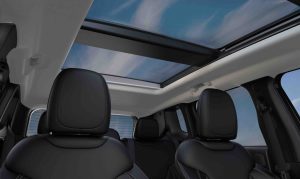
You also get a pair of standard USB charge ports for the backseat passengers – and there’s a 12V power point up front that’s easy to plug into. A growing number of newer-design vehicles don’t even have a 12V power point anymore – and some that do have them located in hidden/hard-to-reach places such as in the back seat area.
All trims come standard with a trailer sway controller (even though this little Jeep is only rated to pull a maximum of 2,000 lbs.).
The Rest
Maybe the most appealing thing about the Renegade is that the Trailhawk version – with almost-SUV capabilities – doesn’t cost that much more than a loaded crossover with a light-duty AWD system.
Or the base-price Renegade.
The price difference between the base Latitude ($27,805) and the Trailhawk ($31,945) is a pretty modest $4,140. Compare that with what it costs to go from a base Wrangler four door ($35,895) to a four-door Rubicon ($49,395) – a difference of $13,500.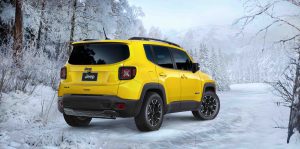
But perhaps the most relevant comparison is the difference in price between a Renegade Trailhawk and a base four-door Wrangler. It’s just shy of $4k, which you could use to option out a Renegade Trailhawk with pretty much everything that’s available, including the nine-speaker premium audio system with subwoofer, heated leather seats (and steering wheel) and a panorama sunroof.
It’s just a shame the Wrangler’s standard 3.6 liter V6 isn’t available as an option with the Renegade.
The Bottom Line
Maybe it’s not a “real” SUV – and that’s true. But maybe you don’t want just another crossover, either.
. . .
If you like what you’ve found here please consider supporting EPautos.
We depend on you to keep the wheels turning!
Our donate button is here.
If you prefer not to use PayPal, our mailing address is:
EPautos
721 Hummingbird Lane SE
Copper Hill, VA 24079
PS: Get an EPautos magnet or sticker or coaster in return for a $20 or more one-time donation or a $10 or more monthly recurring donation. (Please be sure to tell us you want a magnet or sticker or coaster – and also, provide an address, so we know where to mail the thing!)
If you like items like the Keeeeeeev T shirt pictured below, you can find that and more at the EPautos store!





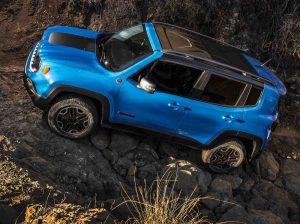

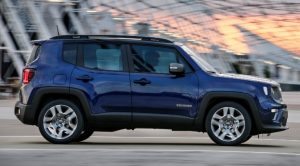







$16,000 car for $27,000. Crap gas mileage for something that size plus the pleasure of having to use premium to feed an underpowered engine.
My little brother and his wife bought a ’17 with the 9 speed trans and 2.4 engine. I liked it well enough, but it was over-priced then. She’d never had a new car in a lifetime.
They’ve since traded for a Nissan Kicks. Well, his wife did.
One of the highest unsold inventory numbers of any model as well.
They’re so dear to Stellantis, just keep them dusted off and shiny…like an aging art installation. They certainly don’t want to sell them.
Eric,
The Renegade is designed for young drivers with high insurance costs…. keeping the power to weight ratio down to keep younger drivers ‘safe’ and their insurance affordable. It’s also why the Compass got the fully detuned 2.0l Hurricane engine at only 201 HP… again, Power-to-weight. I’d love that engine in the Renegade along with a good manual unlike the current one Stellantis offers.
That would be an insta-buy.
Hi Tom,
Naturally! The insurance mafia is to blame for many ills. The chief ill being we’re forced (effectively) to buy its “services.” Luca Brasi phone home…
Just swap in the 1.7 liter version of that engine family….. from the Alfa Romeo 4C…237 hp….
‘A nine speed automatic is standard’ — eric
… where five speeds would be sufficient.
Ever since the eight-speed trans in a buddy’s five-year-old Ram truck croaked — costing him eight thousand ‘Biden’ bucks — I’m allergic to slush-box trannies crammed full of tiny watch-maker gears and electronic chiiiiiips.
Jeep Renegade is built mostly in Italy on a Fiat 500X platform — not necessarily confidence inspiring. With a 2-liter four and a six-speed manual, the Jeep Renegade would have me camped outside the dealer’s door, nose pressed to the glass.
But Fiat Chrysler won’t build what I frickin’ want. So you won’t see me lurking around no car dealer’s lot. Many contain not a single vehicle with a manual trans anymore, and therefore are of no more interest to me than a ladies fashion outlet or a childrens toy store. Sad!
30K plus for that thing? I thought they used to go for 18k new. What teh hell is it with the taillights. They look like a close button on MS Windows programs. Pass on that thing.
Does it have annoyances like ASS and variable cruise?
It’s supposed to look like a Phillips screw head. They’ve been doing that for years.
yeah. Okay. I know. Here’s the rub. I can’t tell the difference between the 2023 version and the 2014 version of the thing. They are all ass ugly.
The Regenade’s dash is like the Wrangler’s, very small. To me, this made it feel much smaller than it actually is, almost claustrophobic.
Providing the USB port instead of the 12 V port at a minimum allows the manufacturers to skimp on wiring another 15 A circuit for the socket. Even if the USB port on the dash is “USB charging”, the most the circuit will have to provide is 5A.
Worse (depending on your point of view) is “USB connection” which only has to provide 900 mA for a USB 3.0 port — blue — and 500 mA — black.
If you need a 12 V port for the radar detector on a test vehicle, some fine Chinesium are available online, but the maximum most of those output would typically be 900 mA. Plus, I’m not sure I’d risk a borrowed car with sketchy manufacturing standards.
Should you be open to entertaining more sinister intent of the replacement, a “USB connection” port may allow the vehicle nanny state reporting tools to monitor what you do with the sail phone while the car is in motion depending on permissions you grant on the phone and the infotainment system. And, even then, I ran into a situation this summer in an unfamiliar vehicle where, lacking a working 12 V port, I plugged into the USB on the dash and could not stop audio redirection from an iPhone into the speaker system.
Some fine Chinesium *adapters* are available online. Sorry.